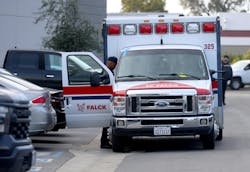Will McCarthy
Bay Area News Group
(TNS)
In a recent — and strongly worded — letter, the managers of two Bay Area cities demanded improvement from Falck, the private ambulance company tasked with responding to emergencies in Alameda County.
The officials from Livermore and Pleasanton alleged poor performance and delayed response times that were “outside of those dictated” by Falck’s contract. In sum, the letter reported that ambulances were late to about one in every six medical emergencies in their cities.
“The expectation of our community is a quicker ambulance response when 911 is called,” the letter read.
The incident was just the latest expression of frustration toward an ambulance company that has had an exclusive contract for emergency medical services in the county since 2019. In the past five years, the Alameda County Health Care Services Agency has levied hundreds of thousands of dollars in fines against Falck for performance issues.
In 2021, they were told to submit a corrective action plan. In 2022, the ambulance company again failed to meet the county’s response-time standard.
When those failures occur, according to Bob Woerner, the former mayor of Livermore and a longtime advocate for improved ambulance service, it is clear who is forced to pick up the slack of an underperforming EMS operator — fire departments.
Although firefighters are often the first responders on a scene, they are not technically allowed to transport patients to the hospital — even in emergency situations. Because Falck has an exclusive contract with the county, only their ambulances are permitted to conduct such transports.
According to Woerner, that often creates a situation in which firefighters end up waiting on the scene 15, 20, or even 25 minutes for an ambulance to arrive, even with critically injured patients.
“In my world, it’s not acceptable,” Woerner said of Falck’s delayed response times. “Falck claimed there were reasons they couldn’t perform, but those reasons weren’t specific to Alameda County, and other counties seemed to be doing okay.”
The situation came to a head in 2022, when Hayward firefighters received a cease-and-desist letter from Falck after they took it upon themselves to transport a series of patients to hospitals. According to Hayward Fire Chief Garrett Contreras, each of those transports involved critical incidents with an extended wait time for an ambulance.
“We’re not trying to be cowboys or do our own thing,” said Contreras. “The service just really has not been good, to be honest.”
Contreras, too, said he’s focused on providing the best possible service to the community, rather than assigning blame. He noted that Falck has not been the only ambulance provider with poor response times during his 30-year career in the county.
“I hope we can have an efficient, effective, sustainable model that will always provide the right resource at the right time to the right patient,” Contreras said. “I’m very optimistic that we are headed in that direction.”
Just six months ago, in October, the Board of Supervisors approved a two-year contract extension for Falck, which will continue providing service to Alameda County for at least the next year.
Some observers think a better system would be the “alliance model,” a public-private partnership where the county EMS agency contracts with the fire departments, which in turn manages the ambulance system. The system is used successfully in Contra Costa County, and San Diego just recently reached an agreement with Falck to take over billing and staffing in a similar model.
Supervisors who could be reached by press time declined to comment.
According to the Alameda County Health Care Services Agency, changes have already been made to improve EMS service in the county. The agency said Falck is boosting staffing by hiring domestic travel EMTs and “formalizing an international program” to bring paramedics from Australia.
The agency also pushed back on response times as an accurate indicator of performance, and argued that clinical outcomes should be emphasized instead.
“Response times are only important and influence clinical care and patient outcomes in a small fraction of cases,” spokesperson Troy Espera wrote in a statement.
But a report this month from the Alameda County Local Agency Formation Commission identified a series of challenges that remain, including an “antiquated business model”, and identified the “greatest challenge to providing adequate services” as the density of call volume within Oakland.
Although Oakland only represents 30 % of the population, 50 % of the call volume in Alameda County comes from the city.
Falck officials said they believe the company can provide the service the county needs.
“Falck is committed to providing the people of Alameda County with timely, expert and compassionate care during medical emergencies,” said Jeff Lucia, a communications officer for Falck. “Our top challenge remains ambulances held at crowded hospitals waiting to offload patients, sometimes for hours. This phenomenon, which is outside our ability to control, causes backups into the 911 system and can delay ambulance responses to 911 calls. We continue to work closely with the hospitals to return ambulances to service as quickly as possible.”
As of August 2023, the most recent time period for which response-time data is available, Falck ambulances had improved performance and maintained compliance in all regions of the county.
Still, as the Alameda County LAFCO report detailed, there are problems with the current ambulance model. The fee-for-service model incentivizes lower staffing. Geographical challenges remain.
The problem is not unique to Alameda County. In the South Bay, staff shortages have led to increased response times, and Santa Clara county report said they needed to add dozens more paramedics to meet the need. Nationally, over 25 % of paramedics leave the field every year.
Ultimately, for the residents of the Bay Area, the name on the side of the ambulance, and even what EMS model it is operating under, is simply not important as quality of care.
“Our residents shouldn’t have to have an understanding on how this all works,” Contreras said. “The expectation the public has is that when there’s a problem, we’re going to fix it. So let’s fix it.”
©2024 MediaNews Group, Inc. Visit at mercurynews.com. Distributed by Tribune Content Agency, LLC.






